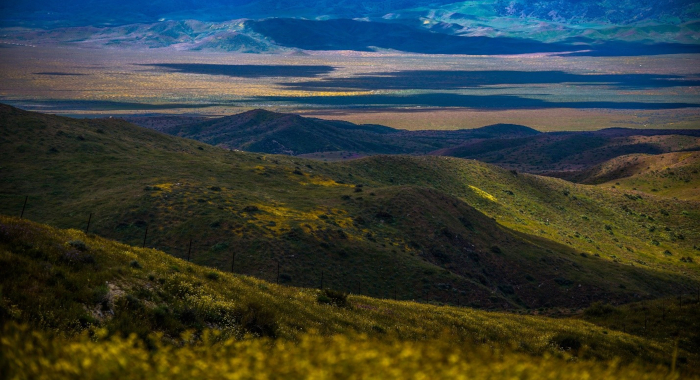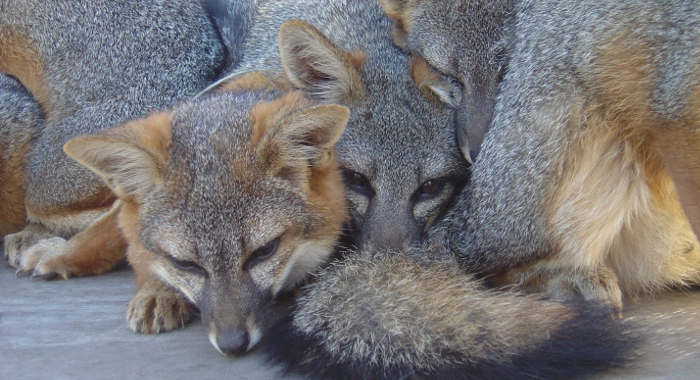Nearly half of California is protected in some land status that prevents most kinds of intensive human land uses. These lands support extensive natural habitats, and for many species, are a critical stronghold in an increasingly human-dominated world.
Yet, changes in the landscape in and near these places have left many in a degraded and precarious condition. Catastrophic wildfire, invasive species, and climate change threaten vast swathes of the state. Protected lands are becoming increasingly isolated by urban and agricultural development, roads, and other infrastructure. Such obstacles can limit a species’ ability to move to across the landscape and adapt to climate change.
Conservancy scientists are working to enhance the resiliency of protected lands in the face of rapid change, and to maintain the landscape connections necessary for plants and animals to adapt over time.


Carrie Schloss, Elizabeth O'Donoghue, Christa Cassidy, Tom Robinson, Serena Unger, Adam Garcia, Dan Rademacher
The Bay Area Greenprint tool provides land use and infrastructure agencies, consultants, and advocates easily accessible, interpretable, and scientifically robust information on habitat and ecosystem…D.R. Cameron, L. Crane, S.S. Parker, J.M. Randall
This book chapter discusses how California's greenhouse gas emission reduction goals spurred solar development in the Mojave Desert—development that could have negative impacts if poorly…Jonathan Q. Richmond, Dustin A. Wood, Michael F. Westphal, Amy G. Vandergast, Adam D. Leache, Lawrence R. Saslaw, H. Scott Butterfield, Robert N. Fisher
This paper uses novel genetic approaches to document how land conversion in the San Joaquin Desert has affected population connectivity and relatedness in the endangered blunt-nosed leopard lizard.…Kathryn M. Langin, T. Scott Sillett, Scott A. Morrison, Cameron K. Ghalambor
Island Scrub-Jays, a species restricted to 250 km2 Santa Cruz Island, CA, have different bill forms depending on whether they occupy oak or pine dominated habitat, a pattern that may be associated…Kristen E. Dybala, Neil Clipperton, Thomas Gardali, Gregory H. Golet, Rodd Kelsey, Stefan Lorenzato, Ron Melcer, Jr., Nathaniel E. Seavy, Joseph G. Silveira
The Conservancy and partners are working to establish riparian ecosystems that provide sufficient habitat to support genetically robust, self-sustaining, and resilient bird populations in…Kristen E. Dybala, Neil Clipperton, Thomas Gardali, Gregory H. Golet, Rodd Kelsey, Stefan Lorenzato, Ronald Melcer, Jr., Nathaniel Seavy, Joseph G. Silveira, Gregory S. Yarris
Quantitative population objectives are necessary to achieve conservation goals of secure or robust wildlife populations, however, existing methods for setting them often require extensive…Kristen Wilson, Erik Lowe, Stacey Wolny, Barry Nickel , Rodd Kelsey
This study demonstrates how science-based planning with stakeholder input can improve and direct conservation investments across existing state and jurisdictional boundaries. The authors set out to…C. L. Boser, C. Hanna, D. A. Holway, K. R. Faulkner, I. Naughton, K. Merrill, J. M. Randall, C. Cory, D.H. Choe , S. A. Morrison
Argentine ants are highly invasive and ecologically damaging. This paper presents a method demonstrated to reduce even large-scale (~400 ha) infestations to non-detectable levels. This protocol…Jongmin Yoon , Helen R. Sofaer, T. Scott Sillett , Scott A. Morrison, Cameron K. Ghalambor
Climate is an important factor in how birds apportion time tending their nests, e.g., how much time they spend brooding versus foraging. This study examines how the roles of males and females of one…Taylor J. Noble , Christopher J. Lortie , Michael Westphal, H.Scott Butterfield
This paper presents camera trap data comprising over 425,000 images from the Carrizo Plain National Monument. This unique collection of digital images allowed the authors to capture animal behaviours…Patrick Baur, Laura Driscoll, Sasha Gennet, Daniel Karp
Since a deadly outbreak of pathogenic E. coli in California spinach in 2006, produce growers have been pressured to implement on-farm practices, such as native vegetation removal, in the name of food…David C. Marvin, Lian Pin Koh, Antony J. Lynam, Serge Wich, Andrew B. Davies, Ramesh Krishnamurthy, Emma Stokes, Ruth Starkey, Gregory P. Asner
Integration of multiple technologies greatly increases the spatial and temporal scales over which ecological patterns and processes can be studied, and threats to protected ecosystems can be…David C. Marvin, Gregory P. Asner
Policies that incentivize forest conservation by monetizing forest carbon ultimately depend on the accuracy of carbon stock estimates. Often, these estimates are based on field inventory sampling. In…Michael F. Westphal, Joseph A. E. Stewart, Erin N. Tennant, H. Scott Butterfield, Barry Sinervo
This paper documents the negative effects of the 2012-2014 drought—the most severe multi-year drought in southwestern North America in the past 1,200 years—on the endangered blunt-nosed…Funk, W.C., R.E. Lovich, P.A. Hohenlohe, C.A. Hofman, S.A. Morrison, T.S. Sillett, C.K. Ghalambor, J.E. Maldonado, T.C. Rick, M.D. Day, T.J. Coonan, K.R. Crooks, A. Dillon, D.K. Garcelon, J.L. King, L.M. Lyren, E.E. Boydston, N. Gould , W.F. Andelt
The genomics revolution provides powerful tools for understanding evolution and advancing conservation. This study applies genomics techniques to examine the evolutionary mechanisms underpinning…M.B. Pesendorfer, T.S. Sillett, S.A. Morrison, A.C. Kamil
Foraging behavior may be influenced by a variety of factors, including food abundance and competitor density. This study examines how such factors affect the seed caching behavior of the Island…Cara Byington, Greg Golet